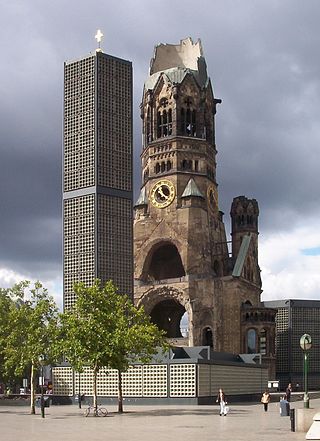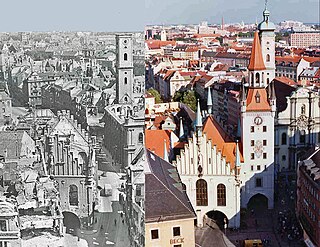
The Red Army Faction, also known as the Baader–Meinhof Group or Baader–Meinhof Gang, was a West German far-left militant group founded in 1970 and active until 1998. The RAF described itself as a communist and anti-imperialist urban guerrilla group. It was engaged in armed resistance against what it considered a fascist state. Members of the RAF generally used the Marxist–Leninist term faction when they wrote in English. Early leadership included Andreas Baader, Ulrike Meinhof, Gudrun Ensslin, and Horst Mahler. The West German government considered the RAF a terrorist organization.
Jan-Carl Raspe was a member of the German militant group, the Red Army Faction (RAF).
Irmgard Möller is a German former militant. She joined the Red Army Faction (RAF) in 1971. After participating in two bombings she was arrested the following year. During the German Autumn of 1977, she was one of the prisoners demanded by the RAF to be freed and was part of an alleged suicide pact in Stammheim Prison with Andreas Baader, Gudrun Ensslin and Jan-Carl Raspe. The other three died and she survived, claiming it was an assassination attempt. She was released from prison in 1994.

Berlin, the capital of Nazi Germany, was subject to 363 air raids during the Second World War. It was bombed by the RAF Bomber Command between 1940 and 1945, the United States Army Air Forces' Eighth Air Force between 1943 and 1945, and the French Air Force in 1940 and between 1944 and 1945 as part of the Allied campaign of strategic bombing of Germany. It was also attacked by aircraft of the Red Air Force in 1941 and particularly in 1945, as Soviet forces closed on the city. British bombers dropped 45,517 tons of bombs, while American aircraft dropped 22,090.3 tons. As the bombings continued, more and more people fled the city. By May 1945, 1.7 million people had fled.
Sieglinde Hofmann was a German militant and member of both the Socialist Patients' Collective and the Red Army Faction.

The West German Embassy siege in Stockholm, Sweden, was a hostage standoff initiated by the Red Army Faction (RAF) on 24 April 1975. Collectively, the attackers referred to themselves as Kommando Holger Meins, after Holger Meins, an RAF member who had died of starvation during a (collective) hunger strike in Wittlich Prison on 9 November 1974.

Members of the Red Army Faction (RAF) can be split up into three generations. The first (founding) generation existed from 1970 onwards. The second generation emerged from 1975 and included people from other groups such as the Socialist Patients' Collective (SPK) and the 2 June Movement. The third generation began in 1982. The group announced its dissolution in 1998.
Katharina Hammerschmidt was a German student of pedagogics and sympathizer of the first generation of Red Army Faction (RAF). She died in 1975 due to throat cancer, which was treated far too late in a West German state prison. When the RAF disbanded in 1998, they remembered Hammerschmidt as one of its victims.
Birgit Hogefeld is a former member of the West German Red Army Faction (RAF).

During World War II, the city of Lübeck was the first German city to be attacked in substantial numbers by the Royal Air Force. The attack on the night of 28 March 1942 created a firestorm that caused severe damage to the historic centre, with bombs destroying three of the main churches and large parts of the built-up area. It led to the retaliatory "Baedeker" raids on historic British cities.
Eva Sybille Haule-Frimpong is a former German terrorist associated with the third generation Red Army Faction (RAF). She took her abitur in Stuttgart before going underground in 1984.
Christian Klar is a former leading member of the second generation Red Army Faction (RAF), active between the 1970s and 1980s. Imprisoned in 1982 in Bruchsal Prison, he was released on 19 December 2008, after serving over 26 years of his life sentence.

The Baader Meinhof Complex is a 2008 German drama film directed by Uli Edel. Written and produced by Bernd Eichinger, it stars Moritz Bleibtreu, Martina Gedeck, and Johanna Wokalek. The film is based on the 1985 German best selling non-fiction book of the same name by Stefan Aust. It retells the story of the early years of the West German far-left terrorist organisation the Rote Armee Fraktion from 1967 to 1977.
In Germany, life imprisonment has an indeterminate length and is the most severe punishment that can be imposed. A person sentenced to life imprisonment may normally apply for parole after having served 15 years. If the parole court rejects the application, the inmate may reapply after a court determined blocking period no longer than two years. If the court has determined a "severe gravity of guilt" exists, parole is delayed for a non-specific period beyond 15 years.
Ernst-Volker Staub is a suspected former German terrorist associated with the third generation Red Army Faction (RAF). He went underground in 1990 and has been looking for since then.
Daniela Marie Luise Klette is a German left-wing militant. She is a suspected former German terrorist associated with the third generation Red Army Faction (RAF). She went underground in the 1990s and was arrested in February 2024.
Burkhard Garweg is a suspected former German terrorist associated with the third generation Red Army Faction (RAF). He went underground in 1990 and has been sought by police since then.

HM Prison Ford is a Category D men's prison, located at Ford, in West Sussex, England, near Arundel and Littlehampton. The prison is operated by His Majesty's Prison Service.

The bombing of Munich took place mainly in the later stages of World War II. Munich was, and is, a significant German city, as much culturally as industrially. Augsburg, thirty-seven miles to the west, was a main centre of diesel engine production, and was also heavily bombed during the war. Although some considerable distance from the United Kingdom, Munich is not a difficult city to find from the air, mainly due to its size, and possibly its proximity to the Austrian Alps to the south-east as a visual reference point. Munich was protected (initially) by its distance from the United Kingdom. After a small air raid in November 1940 the city got little attention from bombers until 1944.

On February 13, 1991, three members of the Red Army Faction (RAF) fired about 250 rounds using a military rifle at the United States embassy in Bonn, Germany.








